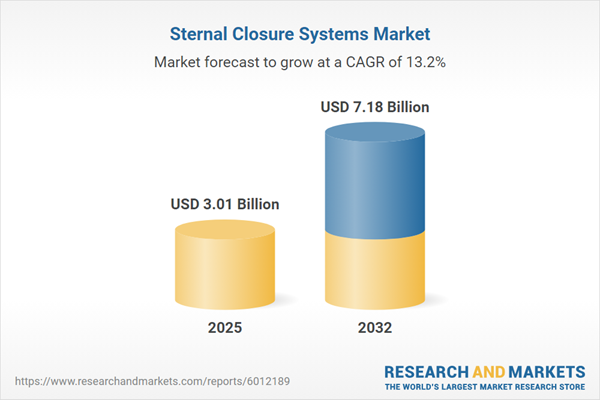Speak directly to the analyst to clarify any post sales queries you may have.
The sternal closure systems market is advancing rapidly as hospitals and manufacturers prioritize safer surgical outcomes, innovations in stabilization, and resilient supply chains. Senior decision-makers are seeking robust market intelligence to inform strategic planning and competitive positioning in this critical medical device sector.
Market Snapshot: Sternal Closure Systems Market Growth and Trends
The sternal closure systems market grew from USD 2.66 billion in 2024 to USD 3.01 billion in 2025. It is expected to continue growing at a CAGR of 13.17%, reaching USD 7.18 billion by 2032. Heightened demand is attributed to increased cardiovascular procedures, regulatory scrutiny, and rapid technological innovation, making this domain essential for device manufacturers, healthcare administrators, and procurement leaders evaluating investment priorities.
Scope & Segmentation of the Sternal Closure Systems Market
This report delivers a detailed breakdown of the sternal closure systems market, focusing on key segments and influential factors:
- Product Type: Composite cables (including braided and coated variants), intramedullary rods (curved and straight designs), rigid plates (double and single configurations), and steel wires (heavy and standard gauge).
- Material: Polymer composites, stainless steel, and titanium, each offering distinct advantages for imaging clarity, mechanical strength, or biocompatibility.
- Application: Use in coronary artery bypass, trauma repairs, and valve replacement procedures, where closure systems are tailored to demands of repeated use, high stress, or minimal anatomical disruption.
- End User: Hospitals, clinics, and ambulatory surgical centers, each with unique procurement criteria and operational priorities.
- Distribution Channel: Direct sales, distribution partnerships, and online sales options enhance market reach and service availability.
- Regional Coverage: In-depth insights across the Americas (with focus on North America and Latin America), Europe, Middle East, Africa, and Asia-Pacific, enabling identification of regional opportunities and competitive landscapes.
- Company Development: Analysis of market-shaping activities among key competitors, including Zimmer Biomet Holdings, Johnson & Johnson, Medtronic, MicroPort Scientific, Sterna Medical, KLS Martin Group, Teleflex, Kinamed, IDEAR S.R.L., and Able Medical Devices.
Key Takeaways for Decision-Makers
- Industry adoption of advanced biomaterials and design methodologies is transforming sternal closure, fostering mechanical stability and improved biological integration for complex surgical cases.
- Minimally invasive techniques and remote monitoring capabilities are gaining traction, supporting improved patient safety, efficient intervention, and streamlined clinical workflows.
- Payer models and reimbursement strategies are evolving as healthcare providers adapt to new supply chain realities, directly influencing device adoption rates in high-volume centers.
- Regional markets are distinguished by differences in regulatory regimes, infrastructure capacity, and access to innovation, dictating tailored go-to-market approaches for sustained growth.
- Competitive advantage increasingly relies on the ability to deliver patient-specific implants and digital integration, as well as on forging collaborations across hospitals, engineers, and materials scientists.
Tariff Impact on the Sternal Closure Systems Market
With new US tariffs on medical device imports introduced in 2025, manufacturers and providers must reevaluate supply chain and cost management strategies. Strategic responses include localizing production, building partnerships with domestic suppliers, and investing in manufacturing upgrades to offset higher import costs. Although short-term disruptions are likely, these measures are projected to strengthen operational resilience and improve traceability throughout the production cycle.
Methodology & Data Sources
The analysis is based on a hybrid research approach combining extensive secondary review of publications, regulatory filings, and patent databases, with primary interviews of surgeons, engineers, procurement professionals, and industry executives. Data triangulation against clinical outcomes, product launches, and supply information ensures rigorous, reliable reporting for senior stakeholders.
Why This Report Matters
- Provides actionable intelligence to support capital allocation, R&D investment, and partnership strategies in the evolving sternal closure systems domain.
- Enables assessment of critical supply chain dynamics, regulatory requirements, and technology trends across core geographies and product segments.
- Helps anticipate shifts in reimbursement, competition, and procurement preferences, supporting proactive, informed market navigation.
Conclusion
Senior leaders who leverage these insights will be positioned to optimize commercial strategies, strengthen operational agility, and drive innovation in sternal closure solutions. The report delivers a comprehensive foundation for maximizing value in today’s dynamic surgical device landscape.
Additional Product Information:
- Purchase of this report includes 1 year online access with quarterly updates.
- This report can be updated on request. Please contact our Customer Experience team using the Ask a Question widget on our website.
Table of Contents
3. Executive Summary
4. Market Overview
7. Cumulative Impact of Artificial Intelligence 2025
Companies Mentioned
The companies profiled in this Sternal Closure Systems market report include:- Zimmer Biomet Holdings, Inc.
- Johnson & Johnson
- Medtronic plc
- MicroPort Scientific Corporation
- Sterna Medical AG
- KLS Martin Group GmbH & Co. KG
- Teleflex Incorporated
- Kinamed Incorporated
- IDEAR S.R.L.
- Able Medical Devices
Table Information
| Report Attribute | Details |
|---|---|
| No. of Pages | 182 |
| Published | October 2025 |
| Forecast Period | 2025 - 2032 |
| Estimated Market Value ( USD | $ 3.01 Billion |
| Forecasted Market Value ( USD | $ 7.18 Billion |
| Compound Annual Growth Rate | 13.1% |
| Regions Covered | Global |
| No. of Companies Mentioned | 11 |









